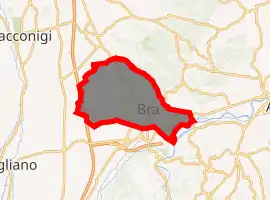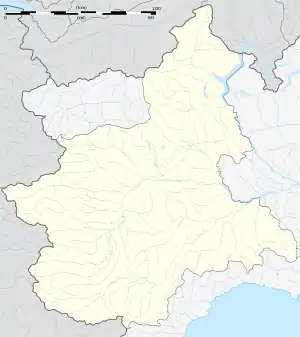Bra, Piedmont
Bra (Italian: [ˈbra], Piedmontese: [ˈbrɑ]) is a town and comune in the province of Cuneo in the northwest Italian region of Piedmont. It is situated 50 kilometres (31 miles) southeast of Turin and 50 km (31 mi) northeast of Cuneo in the area known as Roero.
Bra | |
|---|---|
| Comune di Bra | |
 | |
 Coat of arms | |
Location of Bra 
| |
 Bra Location of Bra in Italy  Bra Bra (Piedmont) | |
| Coordinates: 44°42′N 7°51′E | |
| Country | Italy |
| Region | Piedmont |
| Province | Province of Cuneo (CN) |
| Frazioni | Bandito, Boschetto, Borgo Nuovo, Cà del Bosco, Castelletto, Chiossa, Crociera Burdina, Falchetto, Grione, Matrotti, Piumati, Pollenzo, Quinto Bianco, Riva, Rivo, Ronchi, Sabecco Superiore, San Matteo, San Maurizio, Sant'Agnese, Scatoleri, San Michele, Tetti Bona, Tetti Milanesi, Tetti Rasa |
| Government | |
| • Mayor | Giovanni Fogliato |
| Area | |
| • Total | 59 km2 (23 sq mi) |
| Elevation | 285 m (935 ft) |
| Population (1-1-2017)[2] | |
| • Total | 29,604 |
| • Density | 500/km2 (1,300/sq mi) |
| Demonym(s) | Braidese(i) |
| Time zone | UTC+1 (CET) |
| • Summer (DST) | UTC+2 (CEST) |
| Postal code | 12042 |
| Dialing code | 0172 |
| Patron saint | Madonna dei Fiori |
| Saint day | 8 September |
| Website | Official website |
Bra is the birthplace of the feminist philosopher Adriana Cavarero, politician Emma Bonino, and of the activist Carlo Petrini, founder of the Slow Food movement and of the world's first University of Gastronomic Sciences, whose main campus is located within Bra's municipal boundaries at Pollenzo. Bra is also home to "Cheese," a biennial international festival organised by Slow Food which features the makers of artisanal cheeses from across the world. In 1997 the event attracted some 150,000 visitors.[3]
Among the structures in town is the intricately domed church of Santa Chiara by the late-Baroque architect, Bernardo Antonio Vittone and the church of St. Andrew, the facade of which was designed by the architect Gian Lorenzo Bernini, although not completed until two centuries later.[4]
The town is famous for its gastronomy and the production of Salsiccia di Bra a veal sausage originally made for the Jewish inhabitants of neighbouring Cherasco. It is usually eaten raw.[5]
Twin towns
 Spreitenbach, Switzerland
Spreitenbach, Switzerland Weil der Stadt, Germany
Weil der Stadt, Germany San Sosti, Italy
San Sosti, Italy Corral de Bustos, Argentina
Corral de Bustos, Argentina
Notes
- "Superficie di Comuni Province e Regioni italiane al 9 ottobre 2011". Istat. Retrieved 16 March 2019.
- "Popolazione Residente al 1° Gennaio 2018". Istat. Retrieved 16 March 2019.
- Phoebe Natanson, ‘Italy's Biannual Cheese Orgy’, ABC News, 1 October 2007.
- http://www.museodiffusocuneese.it/, Accessed 27 November 2019
- Commune de Bra